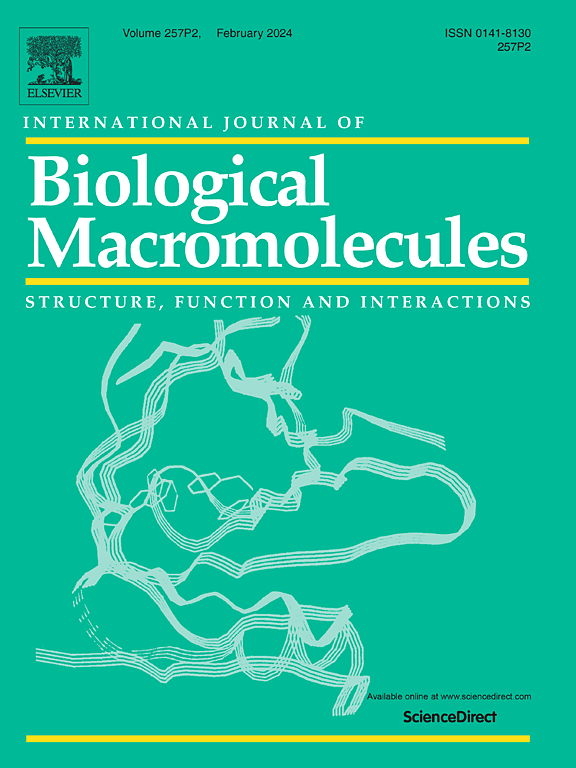IF 7.7
1区 化学
Q1 BIOCHEMISTRY & MOLECULAR BIOLOGY
International Journal of Biological Macromolecules
Pub Date : 2025-04-02
DOI:10.1016/j.ijbiomac.2025.142816
引用次数: 0
摘要
皮肤伤口修复是一个高度综合和重叠的过程,容易受到感染、高氧和过度炎症的影响,从而延迟伤口愈合,甚至导致慢性伤口。本研究利用三维生物打印技术构建了具有仿生皮肤结构的GQL/dGQue双层多功能支架,表皮层由明胶(G)、季铵化壳聚糖(Q)和木质素(L)组成,真皮层由源自皮肤的脱细胞细胞外基质(d)、明胶和槲皮素(Que)组成。结果表明,木质素能有效改善支架的机械性能(杨氏模量超过 90 兆帕),调节支架的适当降解(15 d 内降解率约为 84%),并赋予其良好的紫外线屏蔽性能。此外,GQL/dGQue 对大肠杆菌和金黄色葡萄球菌的抗菌活性分别为 90.76 ± 4.94 % 和 90.34 ± 4.14 %,具有良好的自由基清除能力(87.22 ± 1.71 %)和显著的抗炎特性。体内研究表明,GQL/dGQue 支架能有效防止伤口感染和减轻炎症反应,从而加速毛囊和皮脂腺的血管化和再生,21 d 后伤口闭合率达到 98.29 ± 1.77 %。本文章由计算机程序翻译,如有差异,请以英文原文为准。

A 3D bioprinted gelatin/quaternized chitosan/decellularized extracellular matrix based hybrid bionic scaffold with multifunctionality for infected full-thickness skin wound healing
Skin wound repair, a highly integrated and overlapping process, is susceptible to infection, hyperoxia and excessive inflammation, which can delay wound healing or even lead to chronic wounds. In this study, a GQL/dGQue bilayered multifunctional scaffold, epidermis composed of gelatin (G), quaternized chitosan (Q) and lignin (L), and dermis composed of skin-derived decellularized extracellular matrix (d), gelatin and quercetin (Que), with bionic skin structure, was constructed by 3D bioprinting technology. The results showed that lignin effectively improved the mechanical properties (Young's modulus above 90 MPa) and regulated the appropriate degradation (about 84 % for 15 d) of the scaffold, as well as endowed it with good UV shielding properties. In addition, GQL/dGQue showed prominent antibacterial activity of 90.76 ± 4.94 % and 90.34 ± 4.14 % against E. coli and S. aureus, respectively, good free radical scavenging (87.22 ± 1.71 %) and significant anti-inflammatory properties. In vivo studies demonstrated that GQL/dGQue scaffold could effectively prevent wound infection and mitigate inflammation, thereby accelerating vascularization and regeneration of hair follicle and sebaceous gland with a remarkable wound closure of 98.29 ± 1.77 % at 21 d. Therefore, the GQL/dGQue bilayered multifunctional scaffold has a considerable potential to apply in skin tissue engineering for clinical wound repair.
求助全文
通过发布文献求助,成功后即可免费获取论文全文。
去求助
来源期刊
CiteScore
13.70
自引率
9.80%
发文量
2728
审稿时长
64 days
期刊介绍:
The International Journal of Biological Macromolecules is a well-established international journal dedicated to research on the chemical and biological aspects of natural macromolecules. Focusing on proteins, macromolecular carbohydrates, glycoproteins, proteoglycans, lignins, biological poly-acids, and nucleic acids, the journal presents the latest findings in molecular structure, properties, biological activities, interactions, modifications, and functional properties. Papers must offer new and novel insights, encompassing related model systems, structural conformational studies, theoretical developments, and analytical techniques. Each paper is required to primarily focus on at least one named biological macromolecule, reflected in the title, abstract, and text.

 求助内容:
求助内容: 应助结果提醒方式:
应助结果提醒方式:


